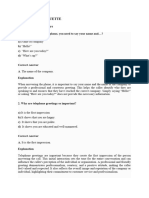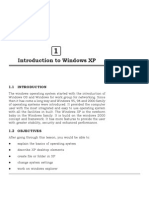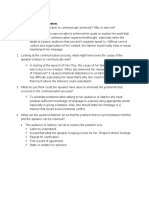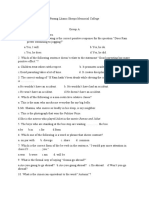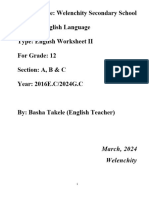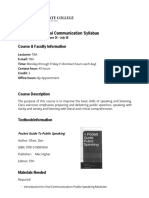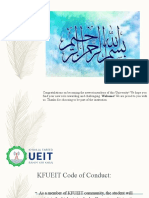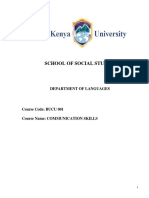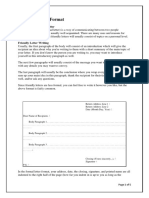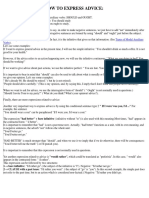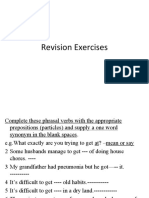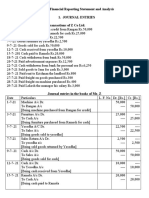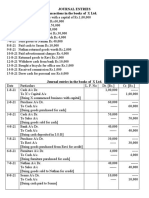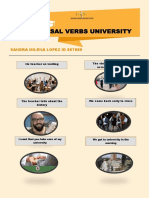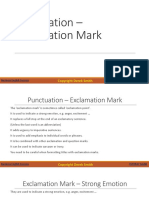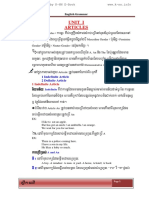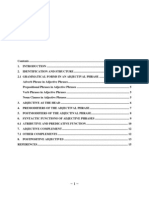Quiz On Punctuation
Uploaded by
Svijayakanthan SelvarajQuiz On Punctuation
Uploaded by
Svijayakanthan SelvarajQuiz on
Professional Communication –
Types of Punctuation
1. Which of these is not a punctuation
mark?
a)Full stop
b) Comma
c) Colon
d) Hash tag
1. Which of these is not a punctuation
mark?
Answer:: d) Hash tag
Answer
Explanation: The main punctuation marks
Explanation:
are full stop, comma, colon, semicolon,
question mark, exclamation mark, hyphen,
dash, brackets, apostrophe
apostrophe.. Hash tag isn’t a
punctuation mark
mark.. It is a symbol used in
social networks, and it has no relevance in
English Grammar
Grammar..
2. The full stop is used at the end of an
indirect question
question..
a) True
b) False
2. The full stop is used at the end of an
indirect question
question..
Answer: a: True
Explanation: The statement is true
Explanation: true..
The full stop is used at the end of an
indirect question
question.. It is used to mark the
close of a complete sentence
sentence.. Example
Example::
I was wondering if you’d be interested
in going to the cinema tonight
tonight..
3. The comma is used after a word
used to address a person.
person.
a) True
b) False
3. The comma is used after a word
used to address a person
person..
Answer: a: True
Explanation: The statement is true
Explanation: true..
The comma used before or after a
word used to address a person
person.. For
example, “Come here, Mohan
Mohan..”
4. Which of these is used after a
nominative absolute?
a) Colon
b) Comma
c) Full stop
d) Question mark
4. Which of these is used after a
nominative absolute?
Answer: b: Comma
Explanation: The comma is used after
Explanation:
a nominative absolute
absolute.. For example, “
Once over, she returned home in
complete peace
peace..”
5. Which of these is used to separate
short co-
co-ordinate clauses of a compound
sentence?
a) Semicolon
b) Comma
c) Full stop
d) Colon
5. Which of these is used to separate
short co-
co-ordinate clauses of a
compound sentence?
Answer: b: Comma
Explanation: The comma is used to
Explanation:
separate short co
co--ordinate clauses of a
compound sentence
sentence.. For example, “
She came, she stooped, she conquered
conquered..”
6. Which of these is used to separate a
series of loosely related clauses?
a) Comma
b) Full stop
c) Semicolon
d) Colon
6. Which of these is used to separate a
series of loosely related clauses?
Answer: c: Semicolon
Explanation: The semicolon is used to
Explanation:
separate a series of loosely related clauses
clauses..
For example
example:: Today we love what
tomorrow we hatehate;; today we seek what
tomorrow we shun
shun..
7. Which of these is used between
sentences which are grammatically
independent?
a) Colon
b) Semicolon
c) Comma
d) Hyphen
7. Which of these is used between
sentences which are grammatically
independent?
Answer: a: Colon
Explanation: The colon is used
Explanation:
between sentences which are
grammatically independent but closely
connected in sense
sense.. For example,
“Truth is the greatest inspiration of all
all::
nothing is of greater value
value..”
8. Which of these is used to convey
proportions?
a) Semicolon
b) Colon
c) Comma
d) Hyphen
8. Which of these is used to convey
proportions?
Answer: b: colon
Explanation: The colon is used to
Explanation:
convey certain conventional
constructions as to convey proportions
like 4 : 1.
9. Choose the correct statement:
a) My aunt who lives in Mumbai is a
doctor.
b) My aunt, who lives in Mumbai, is a
doctor.
c) My aunt, who lives in Mumbai is a
doctor.
d) My aunt who lives in Mumbai, is a
doctor.
9. Choose the correct statement
statement::
Answer: b: My aunt, who lives in
Mumbai, is a doctor.
Explanation: The correct statement is
Explanation: is::
My aunt, who lives in Mumbai, is a
doctor.. All the sentences are correct
doctor
but the commas decide the meaning
meaning..
10.. Choose the correct statement
10 statement::
a) I met a beautiful , European woman
woman..
b) I met a beautiful European woman
woman..
c) I met a beautiful European, woman
woman..
d) I met a beautiful , European,
woman..
woman
10.. Choose the correct statement
10 statement::
Answer: b: I met a beautiful European
woman.
Explanation: The correct statement is:
I met a beautiful European woman.
Ungradable adjectives are hardly ever
preceded by commas.
Quiz on
Professional Communication –
Rules of English Language
11. The ‘e’ which is silent in any word,
11.
is dropped if a suffix beginning with a
vowel is added to it
it..
a) True
b) False
11. The ‘e’ which is silent in any word, is
dropped if a suffix beginning with a vowel is
added to it.
Answer: a: True
Explanation: The statement is true
Explanation: true.. The
‘e’ which is silent in any word, is
dropped if a suffix beginning with a
vowel is added to it it.. For example,
“love” becomes “lovable”
“lovable”..
12. Courage becomes :
a) Courageous
b) Couragous
c) Courageable
d) Couragable
12. Courage becomes :
Answer: a: Courageous
Explanation:
Explanation: “Courage” becomes
“Courageous”.. The silent e is retained
“Courageous”
in words ending with “ce” or “ge”
“ge”.. For
example, “induce” become “inducive”
“inducive”..
13. Rot becomes _____ and pen
becomes ______.
a) roted, pened
b) rotting, pened
c) rotting, penned
d) rotted, penned
13. Rot becomes _____ and pen becomes
______.
Answer: c: rotting, penned
Explanation: Rot becomes rotting and
Explanation:
pen becomes penned
penned.. A monosyllabic
word which ends with a consonant
preceded by a single vowel letter has its
consonant doubled if a suffix beginning
with a vowel is added to it
it..
14. A monosyllabic word with one
14.
vowel cannot end in “c”
“c”..
a) True
b) False
14. A monosyllabic word with one
14.
vowel cannot end in “c”
“c”..
Answer:: b: False
Answer
Explanation:
Explanation: Though most
monosyllabic words with one vowel
end with “k” (sack, rock, sock and so
on), there are some exceptions that end
with just “c” (sac, zinc, talc)
talc)..
15. A monosyllabic word containing
15.
two vowel letters ends with
with::
a) k
b) c
c) ck
d) kc
15. A monosyllabic word containing
two vowel letters ends with:
Answer:: a: k
Answer
Explanation: A monosyllabic word
Explanation:
containing two vowel letters ends with
“k” and not “ck”
“ck”.. For example, book,
creak, etc
etc..
..
16. A word which is monosyllabic and
16.
has one vowel must end with with::
a) mm
b) ll
c) p
d) t
16. A word which is monosyllabic and
has one vowel must end with:
Answer: b: ll
Explanation: A word which is
Explanation:
monosyllabic and has one vowel must
end with ll
ll.. For example, fill, ball, etc
etc....
The only exception to this is “pal”
“pal”..
17. A word which is monosyllabic and
17.
has two vowels must end with
with::
a) ll
b) l
c) ck
d) c
17. A word which is monosyllabic and
has two vowels must end with:
Answer: b: l
Explanation: A word which is
Explanation:
monosyllabic and has two vowels must
end with l. For example, meal, fool,
etc..
etc ..
18. Which of these words is correct?
a) Allign
b) Align
c) Alignn
d) Alline
18. Which of these words is correct?
Answer: b: Align
Explanation: The correct word is
Explanation:
“Align”.. It is often misspelt
“Align” misspelt.. Other
such words are antenna, aperture,
beginning, etc
etc..
..
19. Choose the correct statement:
a) I asked him if he was leaving.
b) I asked him whether he was leaving.
c) I asked him that if he was leaving.
d) I asked him weather he was leaving.
19. Choose the correct statement:
Answer: b: I asked him whether he
was leaving.
Explanation: The correct statement is
Explanation: is::
I asked him whether he was leaving
leaving..
We use whether instead of if where or
not is implied
implied..
20.. Choose the correct statement
20 statement::
a) The boy gave his examination.
b) The boy took his examination.
c) The teacher took his examination.
d) The boy gave away the examination.
20. Choose the correct statement:
Answer: b: The boy took his
examination.
Explanation: The correct statement is
Explanation: is::
The boy took his examination
examination.. The
teacher gives the examination and the
boy takes or sits for it
it..
Quiz on
Professional Communication –
Features of a Paragraph
21. A paragraph gives expression to
thoughts in any writing.
a) True
b) False
21. A paragraph gives expression to
thoughts in any writing.
Answer: a: True
Explanation: The statement is true
Explanation: true.. A
paragraph gives expression to thoughts
in any writing
writing.. It has many features
like length, unity, etc
etc..
..
22. Which of these is not an important
22.
feature of a paragraph?
a) Length
b) Breadth
c) Unity
d) Coherence
22. Which of these is not an important
feature of a paragraph?
Answer: b: Breadth
Explanation: A paragraph gives
Explanation:
expression to thoughts in any writing
writing..
The important features of paragraph
are its length, unity, coherence and
emphasis..
emphasis
23. A paragraph should contain short
sentences.
a) True
b) False
23. A paragraph should contain short
sentences.
Answer: a: True
Explanation: The statement is true
Explanation: true.. A
paragraph should contain short
sentences.. These are preferred
sentences preferred..
24. An average length of sentence in a
24.
paragraph should be _____
a) 15 to 20 words
b) 25 to 30 words
c) 2 to 5 words
d) 5 to 10 words
24. An average length of sentence in a
paragraph should be _____
Answer: a: 15 to 20 words
Explanation: An average
Explanation: length of
sentence should be about 15 to 20
words.. These should be a
words variety in
sentence length
length.. It is better to adopt a
range from 3 to 30 words
words..
25. Which of these is not a feature of a
25.
paragraph?
a) Length
b) Unity
c) Incoherence
d) Correctness
25. Which of these is not a feature of a
paragraph?
Answer: c: Incoherence
Explanation: A paragraph has six
Explanation:
features.. They are
features are:: length, unity,
coherence, emphasis, courtesy and
correctness.. Out of these the important
correctness
ones are length, unity, coherence,
emphasis..
emphasis
26. Where should the main idea be put
26.
up in a paragraph?
a) In the beginning
b) In the middle
c) At the end
d) After the paragraph
26. Where should the main idea be put
up in a paragraph?
Answer: a: In the beginning
Explanation: The main idea should be
Explanation:
put up front within a sentence
sentence.. A
writer must decide the emphasis
accordingly.. The writer should choose
accordingly
words precisely
precisely..
27. Which of these should be avoided in
a paragraph?
a) Courtesy
b) Positive attitude
c) Discriminatory language
d) Politeness
27. Which of these should be avoided in
27.
a paragraph?
Answer: C: Discriminatory language
Explanation: A paragraph writer
Explanation:
should be sincerely tactful, thoughtful
and non
non--discriminatory
discriminatory.. Courteous
communication wins hearts of the
readers and the listeners
listeners..
28. Which of these is not a level of
28.
language?
a) Formal
b) Public
c) Informal
d) Substandard
28. Which of these is not a level of
28.
language?
Answer: b: Public
Explanation: There are three levels of
Explanation:
language.. They are
language are:: formal, informal
and substandard (or non standard)
standard)..
29. Which of these is not a level of
29.
language?
a) Formal writing
b) Informal writing
c) Substandard language
d) Formal speaking
29. Which of these is not a level of
language?
Answer: d: Formal speaking
Explanation: The levels of language
Explanation:
used are in writing
writing.. It is important to
use the right level of language
language.. The
levels of language are
are:: formal, informal
and substandard
substandard..
30. Which of these is associated with
30.
academic pursuits?
a) Informal writing
b) Formal writing
c) Personal writing
d) Substandard writing
30. Which of these is associated with
academic pursuits?
Answer: b: Formal writing
Explanation: Formal writing is
Explanation:
associated with academic pursuits and
scholarly writings e.g.: thesis, research
papers and articles, government
agreements, legal documents
documents..
Dr. Vijayakanthan S
Assistant Professor,
Department of Management Studies,
SRM Institute of Science and Technology,
Vadapalani Campus,
Chennai.
You might also like
- Year 5 English Grammar and Punctuation Test 3100% (1)Year 5 English Grammar and Punctuation Test 34 pages
- Managerial Communication MBA I (Spring 2020) First Term100% (1)Managerial Communication MBA I (Spring 2020) First Term1 page
- Communication Skills - Course Outline ADPNo ratings yetCommunication Skills - Course Outline ADP7 pages
- 2 Ch02 Mastering Team Skills and Interpersonal Communication100% (1)2 Ch02 Mastering Team Skills and Interpersonal Communication74 pages
- Telephone Etiquette Quizz Questions and AnswersNo ratings yetTelephone Etiquette Quizz Questions and Answers6 pages
- Methods of Teaching English As A Foreign Language PDFNo ratings yetMethods of Teaching English As A Foreign Language PDF4 pages
- EDLE7221 Language Testing Open Book Exam (Final) TEASL C1No ratings yetEDLE7221 Language Testing Open Book Exam (Final) TEASL C15 pages
- 4.3 Describing Objects, Places, People and Activities.No ratings yet4.3 Describing Objects, Places, People and Activities.4 pages
- Current Issues English Language Teaching in EthiopiaNo ratings yetCurrent Issues English Language Teaching in Ethiopia10 pages
- English 201 Ell Communication and Presentation Skills (Final MCQS)No ratings yetEnglish 201 Ell Communication and Presentation Skills (Final MCQS)5 pages
- BEd First Year Question (General English)No ratings yetBEd First Year Question (General English)5 pages
- Superior Speaking Course Overview & Resource Guide CEC-2023100% (1)Superior Speaking Course Overview & Resource Guide CEC-2023100 pages
- What's The Difference Between A Conference, A Seminar, A Workshop and A SymposiumNo ratings yetWhat's The Difference Between A Conference, A Seminar, A Workshop and A Symposium3 pages
- Introduction To Oral Communication Syllabus: Course & Faculty Information100% (1)Introduction To Oral Communication Syllabus: Course & Faculty Information12 pages
- 1st MID-TERM EXAM - PHONETICS AND PHONOLOGY - 2019-1100% (1)1st MID-TERM EXAM - PHONETICS AND PHONOLOGY - 2019-16 pages
- Introductory Lecture of Functional EnglishNo ratings yetIntroductory Lecture of Functional English17 pages
- Informal Letter Format: Purpose of A Friendly LetterNo ratings yetInformal Letter Format: Purpose of A Friendly Letter5 pages
- AEN 102 NOTES - The Use of English For Academic Purposes (Revised)No ratings yetAEN 102 NOTES - The Use of English For Academic Purposes (Revised)52 pages
- How To Express Advice:: Types of Modal Auxiliary VerbsNo ratings yetHow To Express Advice:: Types of Modal Auxiliary Verbs1 page
- Grade 12 English: Handout For Second Semester LessonNo ratings yetGrade 12 English: Handout For Second Semester Lesson33 pages
- The Art of Public Speaking: Confidence Is A Key of SuccessNo ratings yetThe Art of Public Speaking: Confidence Is A Key of Success25 pages
- Written Business Communication WorksheetNo ratings yetWritten Business Communication Worksheet9 pages
- Adjective Order 1: Choose The Correct Answer For Each Sentence100% (2)Adjective Order 1: Choose The Correct Answer For Each Sentence2 pages
- Final Punctuation in English Lecture Slides (1)No ratings yetFinal Punctuation in English Lecture Slides (1)50 pages
- Examples: Sympathy and Empathy in SentencesNo ratings yetExamples: Sympathy and Empathy in Sentences3 pages
- Ledger Posting 2.2 MR.Z Established Computer Care Ltd. During August She Completed The Following TransactionsNo ratings yetLedger Posting 2.2 MR.Z Established Computer Care Ltd. During August She Completed The Following Transactions4 pages
- Banking Financial Services Management: Ms. Jebakerupa Roslin Amirtharajan St. Joseph S College of Engineering MBANo ratings yetBanking Financial Services Management: Ms. Jebakerupa Roslin Amirtharajan St. Joseph S College of Engineering MBA82 pages
- MB20104 Financial Reporting Statement and Analysis 1. Journal Entries 1.2 Journalise The Following Transactions of Y LTD100% (2)MB20104 Financial Reporting Statement and Analysis 1. Journal Entries 1.2 Journalise The Following Transactions of Y LTD2 pages
- MB20104 Financial Reporting Statement and Analysis 1. Journal Entries 1.3. Journalise The Following Transactions of Z Co LTDNo ratings yetMB20104 Financial Reporting Statement and Analysis 1. Journal Entries 1.3. Journalise The Following Transactions of Z Co LTD2 pages
- Journal Entries 1. Journalise The Following Transactions in The Books of X LTDNo ratings yetJournal Entries 1. Journalise The Following Transactions in The Books of X LTD2 pages
- 2019 Addis Ababa Science and Technology University: DR - Misrak GirmaNo ratings yet2019 Addis Ababa Science and Technology University: DR - Misrak Girma139 pages
- Week (1-12) Notes (English-2) Yash SahayNo ratings yetWeek (1-12) Notes (English-2) Yash Sahay79 pages
- Grammar Frequency Adverbs Always, Sometimes, Usually Neve100% (1)Grammar Frequency Adverbs Always, Sometimes, Usually Neve4 pages
- Genre Marking Ladders-Biography Genre Marking Ladders-BiographyNo ratings yetGenre Marking Ladders-Biography Genre Marking Ladders-Biography1 page
- Language and Literacy Standards 2017 and B.E.S.T. K-3 Standards Crosswalk Final 04-2020-2No ratings yetLanguage and Literacy Standards 2017 and B.E.S.T. K-3 Standards Crosswalk Final 04-2020-214 pages
- Parts of Speech Practice Create A Menu MakerNo ratings yetParts of Speech Practice Create A Menu Maker5 pages
- Active and Passive Voice Class 6 CBSE English Grammar (PDF)No ratings yetActive and Passive Voice Class 6 CBSE English Grammar (PDF)7 pages
- Punctuation - Exclamation Mark: Business English Success Esforay GMBHNo ratings yetPunctuation - Exclamation Mark: Business English Success Esforay GMBH9 pages
- Error Spotting Asked in Previous Year Prelim Exams: Get High Standard Mock Test Series For All Bank ExamsNo ratings yetError Spotting Asked in Previous Year Prelim Exams: Get High Standard Mock Test Series For All Bank Exams12 pages









